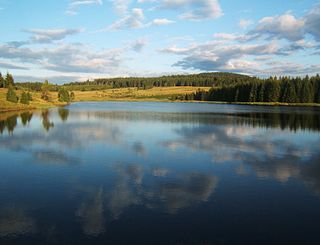
The Ore Mountains lie along the Czech–German border, separating the historical regions of Bohemia in Czech Republic and Saxony in Germany. The highest peaks are the Klínovec in the Czech Republic, which rises to 1,244 metres (4,081 ft) above sea level and the Fichtelberg in Germany.

Freiberg is a university and former mining town in the Free State of Saxony, Germany. It is a so-called Große Kreisstadt and the administrative centre of Mittelsachsen district.

Annaberg-Buchholz is a town in the Free State of Saxony, Germany. Lying in the Ore Mountains, it is the capital of the district of Erzgebirgskreis.

Eibenstock is a town in the western Ore Mountains, in the Erzgebirgskreis, Saxony, Germany. It is situated near the river Mulde.

Marienberg is a town in Germany. It was the district capital of the Mittlerer Erzgebirgskreis in the southern part of Saxony, and since August 2008 it has been part of the new district of Erzgebirgskreis. As of 2020, the town had 16,716 inhabitants.

Brand-Erbisdorf is a small town in the district of Mittelsachsen, in the Free State of Saxony, Germany. It is situated 5 km south of Freiberg. As of 2017, the town has a population of 9,544.

Johanngeorgenstadt is a mining town in Saxony’s Ore Mountains, 17 km south of Aue, and 27 km northwest of Karlovy Vary. It lies in the district of Erzgebirgskreis, on the border with the Czech Republic, is a state-recognized health resort (Erholungsort), and calls itself Stadt des Schwibbogens. Its population decline since the 1950s has been extremely severe falling from 45,000 residents in 1953 to only about one tenth of that now.
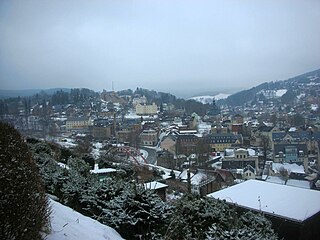
Klingenthal is a town in the Vogtland region, in the Free State of Saxony, south-eastern Germany. It is situated directly on the border with the Czech Republic opposite the Czech town of Kraslice, 29 km southeast of Plauen, and 33 km northwest of Karlovy Vary.
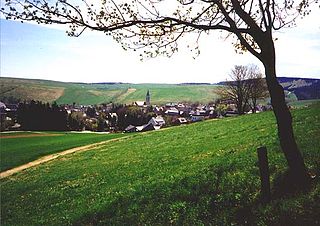
Oberwiesenthal is a town and a ski resort in the district of Erzgebirgskreis in Saxony in Germany. It is situated in the Ore Mountains, on the border with the Czech Republic, 19 km south of Annaberg-Buchholz, and 23 km northeast of Karlovy Vary. At 914 metres (2,999 ft), it is the highest town in Germany. The Olympic and World Championships goldmedalist in ski jumping Jens Weißflog competed for SC Tractor Oberwiesenthal and Oberwiesenthaler SV.

Thum is a small town in the district of Erzgebirgskreis, in the Free State of Saxony, Germany. Thum has a population of about 5800.

Geyer is a town in the district of Erzgebirgskreis, in Saxony, Germany. It has a population of about 4000.

A schwibbogen is a decorative candle-holder from the Ore Mountains (Erzgebirge) region of Saxony, Germany. The first metal schwibbogen was made in 1740 in Johanngeorgenstadt. The early candle arches consisted of a single forged piece of black metal which could be painted. The number of candles varies with the size of the arc, the original design holding eleven. In the UK candle arches or candle bridges are marketed, often just consisting of a simple wooden stepped arch with 7 electric candles. These are not strictly schwibbögen.

Deutschneudorf is a municipality in the district Erzgebirgskreis, in Saxony, Germany.

The Ore Mountain Toy Museum in Seiffen is an internationally known museum of Ore Mountain toys and Ore Mountain folk art. It was opened in 1953 in Seiffen. In 1973 it was joined by the Ore Mountains Open-Air Museum, a folk art and local historic museum with 14 houses typical of the Ore Mountains before 1900 on the edge of the toy village.
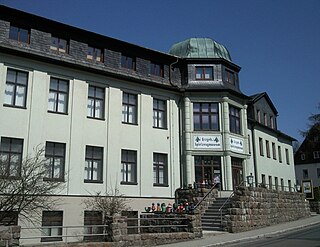
Ore Mountain folk art is a well-known form of highly artistic wood carving from East Germany. It encompasses the diverse forms of expression of the creative work beyond the classical or the modern arts, and in particular the production of figures, sculptures and paintings. In a broader sense, the people's poetry, literature, and the Ore Mountain songs are in itself the folk art. The Ore Mountains claim to be the largest, enclosed folk art area in Germany.

The history of wooden toymaking in the Ore Mountains is closely bound to regional circumstances. The Ore Mountains are located in Central Europe on the border between Germany and the Czech Republic. For many centuries it was a countryside in which the local population eked out a hard existence from the land. Long and harsh winters restricted agriculture; in addition the region had very poor communications. With the onset of ore mining a new line of commerce developed, but the hard labour and high risks involved meant that it was only work for young and strong men. Many were injured or died as a result of accidents. The miners rose early in the morning whilst it was still dark in order to go to work and did not return home again until late in the evening after dark. From those times comes a custom that has survived to the present day, the practice of placing lights in the window. These lights were intended to show the miners the safe way back to the homes of their families.
Reifendrehen is a unique type of toy manufacture using wood turning techniques that was developed in the Ore Mountains in the vicinity of the town of Seiffen and continues there to the present day. The process produces small animals and other figures or even little wooden houses in outline, that are used as toys or to decorate Christmas pyramids or Nativity scenes. The animals and figures so produced are an inherent part of Ore Mountain folk art.

The Miners' Parade is a parade traditionally held in places in Germany where ore was and is smelted. It was and is a public event held by a community or corporation whose employment is linked to mining and smelting. It is usually known in German as a Bergparade, but also as a Berg- und Hüttenparade. It takes place as one of the highlights of a festival. The Miner's Parade is a special form of procession which is organised to march past important dignitaries or which is organized for such high-ranking individuals.
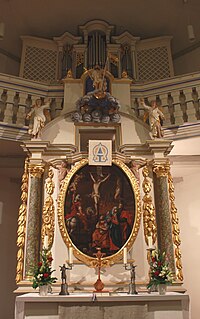
A miner's figure is a traditional Christmas decoration from the Ore Mountains of central Europe. Miners' figures are turned or carved out of wood, and often bear two candles. They are usually displayed together with an angelic figure, also bearing a candle. This pair is intended to symbolize the relationship between man and woman or the worldly and spiritual aspects of life.

Christmas angels are small wooden figures portraying angels often playing an instrument. They can be arranged to an entire orchestra. The origins of artistic angel carving lie in the Ore Mountains where the angels are an integral part of Ore Mountain folk art.


























